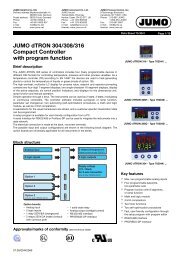Twido Programmable controller
Twido programmable controller - Mejdaf Group
Twido programmable controller - Mejdaf Group
- No tags were found...
You also want an ePaper? Increase the reach of your titles
YUMPU automatically turns print PDFs into web optimized ePapers that Google loves.
Functions (continued) 0<br />
<strong>Twido</strong> programmable <strong>controller</strong> 0<br />
<strong>Twido</strong>Suite programming software<br />
Position control, processing, PID<br />
Position control<br />
<strong>Twido</strong> compact (TWD LCAp 40DRF), modular and Extreme <strong>controller</strong>s offer two<br />
software positioning functions (frequency 7 kHz) (1) which can be used, for example,<br />
for controlling stepper motors:<br />
b PLS (pulse) function - pulse generator output<br />
b PWM function - pulse width modulation output. This function can also be used for<br />
applications with light or sound intensity control (dimmer or volume control function).<br />
Constant<br />
on to off ratio<br />
Variable<br />
on to off ratio<br />
Variable T period<br />
Constant T period<br />
PLS function (pulse, 7 kHz) (1)<br />
The PLS function block generates pulses of xed ratio. In some cases, the frequency<br />
can be xed and in others it is variable (as in control of slopes when driving a stepper<br />
motor). The %PLS function block can be programmed to generate a speci c number<br />
of pulses.<br />
%PLS function blocks are assigned to outputs %Q0.0.0 or %Q0.0.1 on <strong>Twido</strong> base<br />
<strong>controller</strong>s.<br />
The pulse generator signal has a variable period, but with a constant duty cycle<br />
which establishes an ON to OFF ratio of 50% of the period (see illustration opposite).<br />
PWM function (7 kHz) (1)<br />
The PWM function block generates pulses of xed frequency, with a variable ratio between<br />
the high state and low state of the output signal. The ON to OFF duration ratio is a dynamic<br />
variable called %PWM.R, with a range from 0% to 100%.<br />
PWM function blocks are assigned to outputs %Q0.0.0 or %Q0.00.1 on a base<br />
<strong>controller</strong>. The PWM function can be used to control analog module outputs.<br />
The user-de ned %PWM function block generates a signal on output %Q0.0.0 or %Q0.0.1<br />
of <strong>Twido</strong> base <strong>controller</strong>s (see illustration opposite).<br />
Event processing<br />
b Event management by the application.<br />
b 2 priority levels<br />
b 3 types of source:<br />
v 4 event sources based on the basic inputs<br />
v 4 event sources based on the very fast threshold counter (VF counter)<br />
v 1 event source based on the periodic event (Timer)<br />
b Command masked and enabled by the system bits<br />
b Each event executes a single user logic subroutine<br />
b Updating of “re ex” outputs<br />
PID<br />
b 14 PID programming loops<br />
b “Autotuning” algorithm (for software version u 2.5).<br />
b Analog/PWM output<br />
b Linear conversion of measuring input<br />
b 2 alarm levels (high and low) on the “measurement”<br />
b Command output limits<br />
b Direct and inverse action<br />
b 2 animated modes for PID: con guration mode, debug mode<br />
Online modification<br />
This application can be debugged and adjusted in online mode. With this mode, the<br />
application program contained in the PC memory is identical to that in the <strong>controller</strong><br />
memory. Program modi cations can therefore be made directly in the <strong>Twido</strong><br />
<strong>controller</strong>.<br />
(1) 1 or 5 kHz maximum with the <strong>Twido</strong> Extreme <strong>controller</strong> (see page 27).<br />
88







